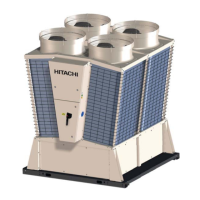Troubleshooting
Technical Catalogue
TCGB0051 rev 0 - 09/2009
80
12.1. Troubleshooting table
The following table shows efcient checking procedures for trouble.
Fault Possible Cause Check/Corrective Action
Compressor Does Not Operate
Interlock Circuit for Chilled Water Pump is Open 1. Check the pump contactor. Repair or replace,
if necessary.
2.Check for the faulty pump.
Electrical Protective Devices Are Tripped. 1. Remove the causes, and reset the “ON”
button. See the following causes.
Incorrect Wiring Connection for Compressor
Power Source
1. Interchange two of three terminals R, S and T
at the main power source terminals.
Compressor Stops on High
Pressure Switch
Excessively High Discharge Pressure 1.See “High Discharge Pressure”
Malfunction of High Pressure Switch 1.Readjust the setting or replace, if defective.
Compressor Stops on
Overcurrent Relay
Excessively High Discharge Pressure and
Suction Pressure
1. See “High Discharge Pressure” and “High
Suction Pressure”.
High or Low Voltage, Single-Phase or Phase
Imbalance
1. Check the power supply line and contactors.
Repair, if necessary.
Loose connection 1. Tighten the loose electrical connection or
repair, if necessary.
Faulty Overcurrent Relay 1.Replace it, if necessary.
Compressor Stops on Freeze
Protection Thermistor
Excessively Low Chilled water Outlet
Temperature
1. Check for excessively low setting of the chilled
water setting knob.
Defective Thermistor 1. Check for malfunction of the thermistor.
Replace, if necessary.
Shortage of Chilled Water Flow 1.Check the rotation of the pump.
Air in water Circuit 1.Purge air.
Compressor Stops on Internal
Thermostat or Discharge Gas
Thermistor
High or Low Voltage, Single-Phase or Phase
Imbalance
1. Check the power supply line and contactors.
Repair, if necessary.
Excessive Superheat 1.Check for refrigerant leakage
Defective Element 1. Check the contact of the internal thermostat
during the cold condition.
Excessive High Discharge Pressure and Low
Suction Pressure
1. See “High Discharge Pressure” and “High
Suction Pressure”.
Insufcient Cooling
High Discharge Pressure or Low Suction
Pressure
1. See “High Discharge Pressure” and “Low
Suction Pressure”.
Improper Thermostat Setting 1.Readjust the setting.
Defective Unload Mechanism 1. Adjust unload mechanism. Repair or replace
unloaded parts, if necessary.
Noisy Compressor
Slugging Due to Liquid Flooding Back to
Compressor
1. Check the superheat of suction gas. Keep the
superheat in proper range.
Worn parts 1. Check for the sound of internal parts. Replace
the compressor, if necessary.
Miscellaneous Noise Loose Fixed Screw 1.Tighten the screws of all parts.
Unloaded Does not Function
Trouble with the Thermistor 1. Adjust the setting temperature.
2. Replace the thermistor.
Trouble with the Solenoid Valve 1.Check the coil in the solenoid valve.
2.Check oil passage for clogging.
Worn Unloader Mechanism 1. Check the unloaded system parts in the
compressor.
High Discharge Pressure
Warm inlet water or Insufcient Water Flow
Through the Condenser
1.Open the valve
Gas Outlet Valve on the Condenser Not
Completely Open
1.Check the valves, capillary tubes and strainer.
Replace, if necessary.
Overcharged Refrigerant 1.Purge the refrigerant.
Condenser Plates Coated with Scales, Lime,
Corrosion and Others
1. Clean the Condenser water plates by chemical
cleaner
Suction Pressure is Higher than Standard 1.See “High Suction Pressure”.
High Condenser Air Temperature or Insufcient
Air Flow through the condenser
1.Check the fan operation
2.Check for coil clogging; clean, if necessary.

